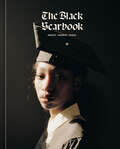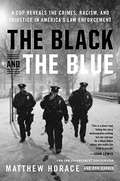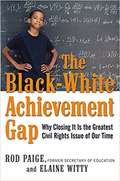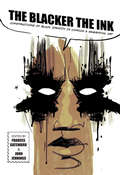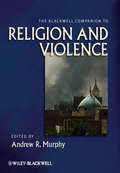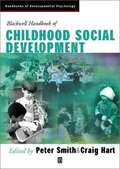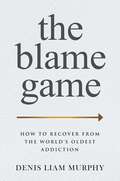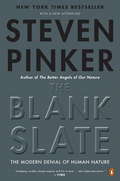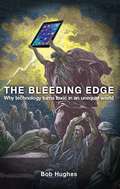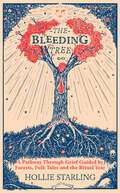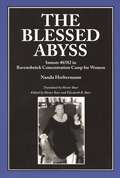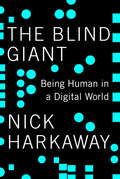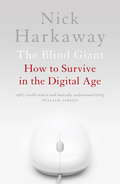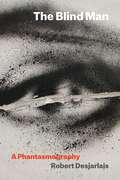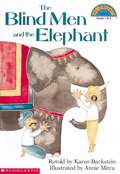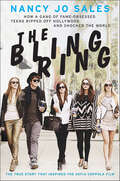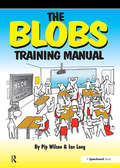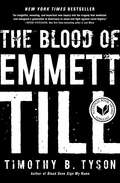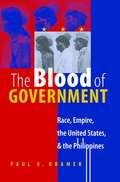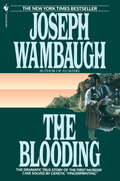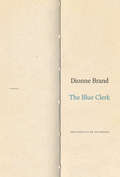- Table View
- List View
The Black Yearbook [Portraits and Stories]
by Adraint Khadafhi BerealA gripping exploration of the joys, hardships, and truths of Black students through intimate, honest dialogues and stunning photography, with a foreword by Kiese Laymon, author of Heavy&“A radical, reverential, and restorative document of community.&”—Rebecca Bengal, author of Strange Hours: Photography, Memory, and the Lives of ArtistsWhen photographer Adraint Bereal graduated from the University of Texas, he self-published an impressive volume of portraits, personal statements, and interviews that explored UT's campus culture and offered an intimate look at the lives of Black students matriculating within a majority white space. Bereal's work was inspired by his first photo exhibition at the George Washington Carver Museum in Austin, entitled 1.7, that unearthed the experiences of the 925 Black men that made up just 1.7% of UT's total 52,000 student body.Now Bereal expands the scope of his original project and visits colleges nationwide, from Historically Black Colleges and Universities (HBCUs) to predominantly white institutions to trade schools and more. Rather than dwelling on the monolith of trauma often associated with Black narratives, Bereal is dedicated to using honest dialogue to share stories of true joy and triumph amidst the hardships, prejudices, and internal struggles. Using an exciting and eclectic design approach to accompany the portraits and stories, each individual profile effectively conveys the interviewee's unique voice, tone, and background.The Black Yearbook reframes society's stereotypical perception of higher education by representing and celebrating the wide range of Black experiences on campuses.
The Black and the Blue: A Cop Reveals the Crimes, Racism, and Injustice in America's Law Enforcement
by Matthew Horace Ron HarrisCNN contributor offers a searing indictment of America's law enforcement."This is a must-read.... Telling this story demonstrates nothing but raw courage for a black police officer who wants the truth to prevail." --John Lewis"[T]his [is a] hard-hitting, convincing indictment of the biases in today's law enforcement.... A must-read for anyone interested in understanding and solving these problems." --Booklist (starred review)Matthew Horace was an officer at the federal, state, and local level for 28 years working in every state in the country. Yet it was after seven years of service when Horace found himself face-down on the ground with a gun pointed at his head by a white fellow officer, that he fully understood the racism seething within America's police departments. Using gut-wrenching reportage, on-the-ground research, and personal accounts garnered by interviews with police and government officials around the country, Horace presents an insider's examination of police tactics, which he concludes is an "archaic system" built on "toxic brotherhood." Horace dissects some of the nation's most highly publicized police shootings and communities highlighted in the Black Lives Matter movement and beyond to explain how these systems and tactics have had detrimental outcomes to the people they serve. Horace provides fresh analysis on communities experiencing the high killing and imprisonment rates due to racist policing such as Ferguson, New Orleans, Baltimore, and Chicago from a law enforcement point of view and uncovers what has sown the seeds of violence.Timely and provocative, The Black and The Blue sheds light on what truly goes on behind the blue line.
The Black-White Achievement Gap: Why Closing It Is The Greatest Civil Rights Issue Of Our Time
by Rod Paige Elaine WITTYWhen it comes to race in America, we must face one uncomfortable but undeniable fact. Almost 50 years after the birth of the civil rights movement, inequality still reigns supreme in our classrooms. At a time when African-American students trail their white peers on academic tests and experience high dropout rates, low college completion rates, and a tendency to shy away from majors in hard sciences and mathematics, the Black-White achievement gap in our schools has become the major barrier to racial equality and social justice in America. In fact, it is arguably the greatest civil rights issue of our time. The Black-White Achievement Gap is a call to action for this country to face up to and confront this crisis head on. Renowned former Secretary of Education Rod Paige believes we can close this gap. In this thought-provoking book, he and Elaine Witty trace the history of the achievement gap, discuss its relevance to racial equality and social justice, examine popular explanations, and offer suggestions for the type of committed leadership and community involvement needed to close it. African-American leaders need to rally around this important cause if we are to make real progress since students’ academic performance is a function not only of school quality, but of home and community factors as well. The Black-White Achievement Gap is an unflinching and long overdue look at the very real problem of racial disparity in our schools and what we must do to solve it.
The Blacker the Ink
by John Jennings Craig Fischer Frances Gateward Rebecca Wanzo William Lafi Youmans Kinohi Nishikawa Blair Davis Nancy Goldstein Daniel F. Yezbick Sally Mcwilliams James J. Zeigler Qiana Whitted Reynaldo Anderson Hershini Bhana Young Robin Means Coleman Patrick F. Walter Consuela Francis Andre CarringtonWhen many think of comic books the first thing that comes to mind are caped crusaders and spandex-wearing super-heroes. Perhaps, inevitably, these images are of white men (and more rarely, women). It was not until the 1970s that African American superheroes such as Luke Cage, Blade, and others emerged. But as this exciting new collection reveals, these superhero comics are only one small component in a wealth of representations of black characters within comic strips, comic books, and graphic novels over the past century. The Blacker the Ink is the first book to explore not only the diverse range of black characters in comics, but also the multitude of ways that black artists, writers, and publishers have made a mark on the industry. Organized thematically into "panels" in tribute to sequential art published in the funny pages of newspapers, the fifteen original essays take us on a journey that reaches from the African American newspaper comics of the 1930s to the Francophone graphic novels of the 2000s. Even as it demonstrates the wide spectrum of images of African Americans in comics and sequential art, the collection also identifies common character types and themes running through everything from the strip The Boondocks to the graphic novel Nat Turner. Though it does not shy away from examining the legacy of racial stereotypes in comics and racial biases in the industry, The Blacker the Ink also offers inspiring stories of trailblazing African American artists and writers. Whether you are a diehard comic book fan or a casual reader of the funny pages, these essays will give you a new appreciation for how black characters and creators have brought a vibrant splash of color to the world of comics.
The Blackout in Britain and Germany, 1939–1945
by Marc WiggamThis book is the first major study of the blackout in the Second World War. Developing a comparative history of this system of civil defense in Britain and Germany, it begins by exploring how the blackout was planned for in both countries, and how the threat of aerial bombing framed its development. It then examines how well the blackout was adhered to, paying particular regard to the tension between its military value and the difficulties it caused civilians. The book then moves on to discuss how the blackout undermined the perception of security on the home front, especially for women. The final chapter examines the impact of the blackout on industry and transport. Arguing that the blackout formed an integral part in mobilising and legitimating British and German wartime discourses of community, fairness and morality, the book explores its profound impact on both countries.
The Blackwell Companion to Religion and Violence (Wiley Blackwell Companions To Religion Ser. #57)
by Andrew R. MurphyThe timely Blackwell Companion to Religion and Violence brings together an international, interdisciplinary group of scholars who provide a coherent state of the art overview of the complex relationships between religion and violence. This companion tackles one of the most important topics in the field of Religion in the twenty-first century, pulling together a unique collection of cutting-edge work A focused collection of high-quality scholarship provides readers with a state-of-the-art account of the latest work in this field The contributors are broad-ranging, international, and interdisciplinary, and include historians, political scientists, religious studies scholars, sociologists, anthropologists, theologians, scholars of women's and gender studies and communication
The Blackwell Handbook of Childhood Social Development
by Peter K. Smith Craig HartThis handbook provides an authoritative and up-to-date overview of research and theory about social development in children from pre-school age to the onset of adolescence. It forms part of a series of four Blackwell Handbooks in Developmental Psychology spanning infancy to adolescence. Contributors come from Australia, Belgium, Canada, Germany, Italy, the Netherlands, the UK and the US. It covers all the major topics in research and theory about childhood social development, and synthesizes the latest research findings in an accessible manner.
The Blame Game: How to Recover from the World's Oldest Addiction
by Denis Liam MurphyHonest happiness and effortless living are possible. You just have to heal from a blame addiction you didn&’t know you had.Life is designed to be effortless. It might not seem like it right now, but a deep sense of confidence, freedom, and serenity is attainable regardless of your situation. All you need to do is address ONE habit. One that you didn&’t know you had. Anxiety, depression, anger, shame, and guilt are all symptoms of your blame addiction. Spend a month on the BLAME recovery process. Within 30 days… YOUR MENTAL HEALTH WILL IMPROVE. YOUR PHYSICAL PERFORMANCE WILL BE ENHANCED. YOUR ENERGY LEVELS WILL INCREASE. YOUR LIFE WILL CHANGE. From the very first chapter of The Blame Game, you will not only start to release years of built-up frustration, resentment, and sadness, you will begin to find out who you honestly are—all so you can find out what your true purpose is.
The Blank Slate: The Modern Denial of Human Nature
by Steven PinkerIn The Blank Slate, Steven Pinker, one of the world's leading experts on language and the mind, explores the idea of human nature and its moral, emotional, and political colorings. With characteristic wit, lucidity, and insight, Pinker argues that the dogma that the mind has no innate traits-a doctrine held by many intellectuals during the past century-denies our common humanity and our individual preferences, replaces objective analyses of social problems with feel-good slogans, and distorts our understanding of politics, violence, parenting, and the arts. Injecting calm and rationality into debates that are notorious for ax-grinding and mud-slinging, Pinker shows the importance of an honest acknowledgment of human nature based on science and common sense.
The Bleeding Edge: Why Technology Turns Toxic in an Unequal World
by Bob Hughes<P>Capitalism likes us to believe in the steady, inevitable march of progress, from the abacus to the iPad. But the historical record tells of innumerable roads not taken, all of which could have led to better, more equal worlds, and still can. <P>Academic and activist Bob Hughes puts flesh on the bones of the idea that 'another world is possible', using as evidence the technology that capitalism claims as quintessentially its own: the computer in all its forms. <P>Contrary to popular belief capitalism does not do innovation well - instead suppressing or appropriating it. This book shows that great innovations have never emerged from capitalism per se, but always from the utopian moments that occur behind the capitalist's back. And when it does embrace an innovation, the results are often the diametric opposite of what the innovators intended.In this thorough and meticulous work Hughes argues that if we only prioritized equality over materialism then superior and more diverse technologies would emerge leading to a richer more sustainable world. <P>Bob Hughes is an academic, activist, and author. Formerly he taught electronic media Oxford Brookes University and now spends his time researching and campaigning against inequality. He is author of Dust or Magic, a book for digital multimedia workers, about how people "do good stuff with computers." He is a member of No One is Illegal, which campaigns for the total abolition of immigration controls, for whom he has written many articles.
The Bleeding Tree: A Pathway Through Grief Guided by Forests, Folk Tales and the Ritual Year
by Hollie StarlingIt was the last of the ebbing days, the brink of the new season. It was the murky hours, the clove between sunset and sunrise. It was a tall tree with deep roots and it had been bleeding for a long while.As summer falls into autumn, Hollie Starling is hit by the heart-stopping news that her father has died by suicide. Thrust into a state of 'grief on hard mode', Hollie feels underserved by current attitudes toward grief and so seeks another way through the dark.Following her first year without her father, Hollie embraces her lifelong interest in folklore and turns to the healing power of nature, the changing seasons and the rituals of ancient communities. The Bleeding Tree is an unflinching year-zero guidebook to grief that shows us that by looking back to past traditions of bereavement we can all find our own way forward.'Starling's account of family life is riveting and narrated with grace and honesty, counterpointing the personal with the mythic.' - Irish Times
The Blessed Abyss: Inmate #6582 in Ravensbrück Concentration Camp for Women
by Hester Baer Elizabeth R. Baer Nanda HerbermannOn February 4, 1941, Nanda Herbermann, a German Catholic writer and editor, was arrested by the Gestapo in Münster, Germany. Accused of collaboration with the Catholic movement, Herbermann was deported to Ravensbrück Concentration Camp for Women in July 1941 and later released upon direct orders from Heinrich Himmler on March 19, 1943. Although she was instructed by the Gestapo not to reveal information about the camp, Herbermann soon began to record her memories of her experiences. The Blessed Abyss was originally published in German under the imprint of the Allied occupation forces in 1946, and it now appears in English for the first time. Hester Baer and Elizabeth Baer include an extensive introduction that situates Herbermann's work within current debates about gender and the Holocaust and provides historical and biographical information about Herbermann, Ravensbrück, and the Third Reich.
The Blind Giant
by Nick HarkawayNick Harkaway, author of Angelmaker, presents a rousing and energizing look at how we can meaningfully and constructively engage with technology--creating an essential handbook for anyone trying to be human in a digital age. Some say our devices will lead us to ruin: isolating us from our neighbors, warping communication, delivering an unregulated flood of information that will destroy our humanity. Some say they will be our salvation: enabling global communication and social engagement, putting all the world's facts at our fingertips, and erasing the barriers that divide us, bringing out the best qualities of humanity. In The Blind Giant, novelist and blogger Nick Harkaway takes us on a lucid, insightful and personal tour of how we live our lives in our technology-obsessed culture. A self-described "missing link" between the pre-Internet generation and the "digital natives" who have grown up with technology, Nick is an enthusiastic guide to digital culture who weaves together examples from literature, psychology, neurology, sociology, history, and his own life while exploring the hazards and joys of the human-machine relationship. In the final analysis, whether we meaningfully engage with the machines we have created, or risk living in a world which is designed to serve computers and corporations rather than people, this book is a must-read for anyone concerned with our digital future.
The Blind Giant: How to Survive in the Digital Age
by Nick HarkawayThe digital age. An age of isolation, warped communication, disintegrating community. Where unfiltered and unregulated information pours relentlessly into our lives, destroying what it means to be human. Or an age of marvels. Where there is a world of wonder at our fingertips. Where we can communicate across the globe, learn in the blink of an eye, pull down the barriers that divide us and move forward together. Whatever your reaction to technological culture, the speed with which our world is changing is both mesmerising and challenging. In The Blind Giant, novelist and tech blogger Nick Harkaway draws together fascinating and disparate ideas to challenge the notion that digital culture is the source of all our modern ills, while at the same time showing where the dangers are real and suggesting how they can be combated. Ultimately, the choice is ours: engage with the machines that we have created, or risk creating a world which is designed for corporations and computers rather than people. This is an essential handbook for everyone trying to be human in a digital age.
The Blind Giant: How to Survive in the Digital Age
by Nick HarkawayThe digital age. An age of isolation, warped communication, disintegrating community. Where unfiltered and unregulated information pours relentlessly into our lives, destroying what it means to be human. Or an age of marvels. Where there is a world of wonder at our fingertips. Where we can communicate across the globe, learn in the blink of an eye, pull down the barriers that divide us and move forward together. Whatever your reaction to technological culture, the speed with which our world is changing is both mesmerising and challenging. In The Blind Giant, novelist and tech blogger Nick Harkaway draws together fascinating and disparate ideas to challenge the notion that digital culture is the source of all our modern ills, while at the same time showing where the dangers are real and suggesting how they can be combated. Ultimately, the choice is ours: engage with the machines that we have created, or risk creating a world which is designed for corporations and computers rather than people. This is an essential handbook for everyone trying to be human in a digital age.
The Blind Man: A Phantasmography (Thinking from Elsewhere)
by Robert DesjarlaisThe Blind Man: A Phantasmography examines the complicated forces of perception, imagination, and phantasms of encounter in the contemporary world. In considering photographs he took while he was traveling in France, anthropologist and writer Robert Desjarlais reflects on a few pictures that show the features of a man, apparently blind, who begs for money at a religious site in Paris, frequented by tourists. In perceiving this stranger and the images his appearance projects, he begins to imagine what this man’s life is like and how he perceives the world around him.Written in journal form, the book narrates Desjarlais’s pursuit of the man portrayed in the photographs. He travels to Paris and tries to meet with him. Eventually, Desjarlais becomes unsure as to what he sees, hears, or remembers. Through these interpretive dilemmas he senses the complexities of perception, where all is multiple, shifting, spectral, a surge of phantasms in which the actual and the imagined are endlessly blurred and intertwined. His mind shifts from thinking about photographs and images to being fixed on the visceral force of apparitions. His own vision is affected in a troubling way.Composed of an intricate weave of text and image, The Blind Man attends to pressing issues in contemporary life: the fraught dimensions of photographic capture; encounters with others and alterity; the politics of looking; media images of violence and abjection; and the nature of fantasy and imaginative construal. Through a wide-ranging inquiry into histories of imagination, Desjarlais inscribes the need for a “phantasmography”—a writing of phantasms, a graphic inscription of the flows and currents of fantasy and fabulation.
The Blind Men and the Elephant
by Lillian F. QuigleyIn this Indian Folk Tale six blind men learn how to share their impressions to make a whole.
The Blind in School and Society: A Psychological Study
by Thomas D. CutsforthThe purpose of this book is to help acquaint the seeing with the blind and the blind with themselves.
The Bling Ring: How a Gang of Fame-Obsessed Teens Ripped Off Hollywood and Shocked the World
by Nancy Jo SalesThe inspiration for the Sofia Coppola film. The true story of the privileged teenagers who stole millions of dollars worth of valuables from celebrities.With a list of victims that reads like a “Who’s Who” of young Hollywood, including Lindsay Lohan, Orlando Bloom, Paris Hilton, and Rachel Bilson, The Bling Ring is the stuff of writers’ imaginations—with one exception—it’s a true story.The media asked: Why would a group of kids who already had designer clothes, money, cars, and status take such risks? Award-winning journalist Nancy Jo Sales found the answer: They did it because they could. And because it was easy.“A great piece of crime reportage,” The Bling Ring is a shocking look at the seedy world of the real young Hollywood (The New York Observer).“For a satire on America’s modern day celebrity culture, The Bling Ring is hard to beat.” —The Guardian“Sales [is] a superlative reporter.” —People“Absolutely terrific.” —The Awl“Brilliant.” —Grazia Daily
The Blobs Training Manual: A Speechmark Practical Training Manual
by Pip Wilson Ian LongDiscover the full potential of the Blobs! Eagerly awaited, this comprehensive resource book for understanding and using Blobs provides: a fantastic insight into Blobs and Blob Trees, their development and the theory behind them; clear instructions on how Blobs can be used to discuss a wide variety of important issues, emotions or feelings; session ideas and activities for working with groups and individuals of all ages; questions to use with the Blobs; and, what not to do when using Blobs! Ideal for anyone new to the Blobs resources, this manual will also provide background information and additional ideas for those familiar with this engaging series.
The Blood of Emmett Till
by Timothy B. TysonThis extraordinary New York Times bestseller reexamines a pivotal event of the civil rights movement—the 1955 lynching of Emmett Till—&“and demands that we do the one vital thing we aren&’t often enough asked to do with history: learn from it&” (The Atlantic). * A New York Times Notable Book * A Washington Post Notable Book * Longlisted for the National Book Award * Winner of the Robert F. Kennedy Book Award *An NPR, Los Angeles Times, and Atlanta Journal-Constitution Best Book of the Year *In 1955, white men in the Mississippi Delta lynched a fourteen-year-old from Chicago named Emmett Till. His murder was part of a wave of white terrorism in the wake of the 1954 Supreme Court decision that declared public school segregation unconstitutional. Only weeks later, Rosa Parks thought about young Emmett as she refused to move to the back of a city bus in Montgomery, Alabama. Five years later, Black students who called themselves &“the Emmett Till generation&” launched sit-in campaigns that turned the struggle for civil rights into a mass movement. Till&’s lynching became the most notorious hate crime in American history. But what actually happened to Emmett Till—not the icon of injustice, but the flesh-and-blood boy? Part detective story, part political history, The Blood of Emmett Till &“unfolds like a movie&” (The Atlanta Journal-Constitution), drawing on a wealth of new evidence, including a shocking admission of Till&’s innocence from the woman in whose name he was killed. &“Jolting and powerful&” (The Washington Post), the book &“provides fresh insight into the way race has informed and deformed our democratic institutions&” (Diane McWhorter, Pulitzer Prize–winning author of Carry Me Home) and &“calls us to the cause of justice today&” (Rev. Dr. William J. Barber, II, president of the North Carolina NAACP).
The Blood of Government
by Paul A. KramerIn 1899 the United States, having announced its arrival as a world power during the Spanish-Cuban-American War, inaugurated a brutal war of imperial conquest against the Philippine Republic. Over the next five decades, U.S. imperialists justified their colonial empire by crafting novel racial ideologies adapted to new realities of collaboration and anticolonial resistance. In this pathbreaking, transnational study, Paul A. Kramer reveals how racial politics served U.S. empire, and how empire-building in turn transformed ideas of race and nation in both the United States and the Philippines.Kramer argues that Philippine-American colonial history was characterized by struggles over sovereignty and recognition. In the wake of a racial-exterminist war, U.S. colonialists, in dialogue with Filipino elites, divided the Philippine population into "civilized" Christians and "savage" animists and Muslims. The former were subjected to a calibrated colonialism that gradually extended them self-government as they demonstrated their "capacities." The latter were governed first by Americans, then by Christian Filipinos who had proven themselves worthy of shouldering the "white man's burden." Ultimately, however, this racial vision of imperial nation-building collided with U.S. nativist efforts to insulate the United States from its colonies, even at the cost of Philippine independence. Kramer provides an innovative account of the global transformations of race and the centrality of empire to twentieth-century U.S. and Philippine histories.
The Blooding
by Joseph WambaughFor the first time, Joseph Wambaugh turns his attention outside the United States to deal with two murders in neighboring English Midlands villages-ancient villages that still have whitewashed Tudor cottages, pavements too narrow for passing baby prams, streets barely wide enough for two cars, and churches or pubs as the sites of community life. What intrigues the master of true-crime writing is that out of the sleepy setting grew a landmark case: the first murders solved by genetic fingerprinting. The victims of the terrifying rape-murders -two fifteen-year-old girls who do not know each other-have in common one fatal mistake: they choose to walk village footpaths bordering the lands of a psychiatric hospital. Forever after, the names Ten Pound Lane and The Black Pad will evoke fear and dread. The murders occur three years apart, and during all those years the members of the Leicestershire constabulary never give up their search. The local newspapers cooperate by keeping the cases alive. And the families of the victims try to cope with the chaos of their existence.
The Blooding
by Joseph WambaughFifteen-year-old Lynda Mann's savagely raped and strangled body is found along a shady footpath near the English village of Narborough. Though a massive 150-man dragnet is launched, the case remains unsolved. Three years later the killer strikes again, raping and strangling teenager Dawn Ashforth only a stone's throw from where Lynda was so brutally murdered. But it will take four years, a scientific breakthrough, the largest manhunt in British crime annals, and the blooding of more than four thousand men before the real killer is found.
The Blue Clerk: Ars Poetica in 59 Versos
by Dionne Brand<P>On a lonely wharf a clerk in an ink-blue coat inspects bales and bales of paper that hold a poet's accumulated left-hand pages—the unwritten, the withheld, the unexpressed, the withdrawn, the restrained, the word-shard. <P>In The Blue Clerk renowned poet Dionne Brand stages a conversation and an argument between the poet and the Blue Clerk, who is the keeper of the poet's pages. In their dialogues—which take shape as a series of haunting prose poems—the poet and the clerk invoke a host of writers, philosophers, and artists, from Jacob Lawrence, Lola Kiepja, and Walter Benjamin to John Coltrane, Josephine Turalba, and Jorge Luis Borges. <P>Through these essay poems, Brand explores memory, language, culture, and time while intimately interrogating the act and difficulty of writing, the relationship between the poet and the world, and the link between author and art. Inviting the reader to engage with the resonant meanings of the withheld, Brand offers a profound and moving philosophy of writing and a wide-ranging analysis of the present world.
